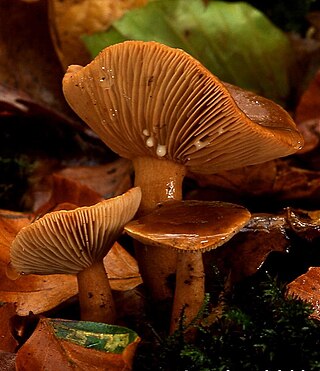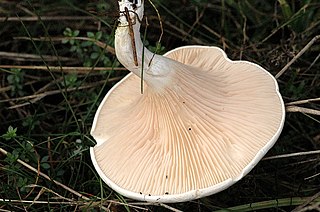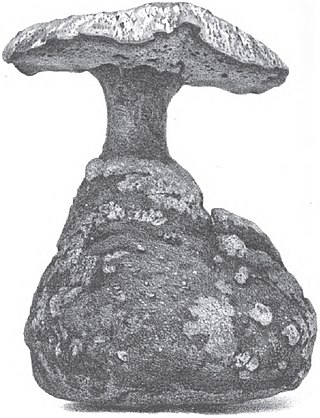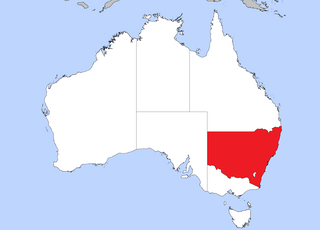Related Research Articles

Elias Magnus Fries was a Swedish mycologist and botanist. He is sometimes called the "Linnaeus of Mycology". In his works he described and assigned botanical names to hundreds of fungus and lichen species, many of which remain authoritative today.
Hymenomycetes was formerly the largest taxonomic group of fungi within the division Basidiomycota, but the term is no longer taxonomically relevant. Many familiar fungi belong to this class, including bracket fungi and toadstools. This class contained the orders Agaricales, Boletales, and Russulales.

A basidium is a microscopic spore-producing structure found on the hymenophore of reproductive bodies of basidiomycete fungi. These bodies also called tertiary mycelia, which are highly coiled versions of secondary mycelia. The presence of basidia is one of the main characteristic features of the genus. A basidium usually bears four sexual spores called basidiospores. Occasionally the number may be two or even eight. Each reproductive spore is produced at the tip of a narrow prong or horn called a sterigma, and is forcefully expelled at full growth.

The Cantharellaceae are a family of fungi in the order Cantharellales. The family contains the chanterelles and related species, a group of fungi that superficially resemble agarics but have smooth, wrinkled, or gill-like hymenophores. Species in the family are ectomycorrhizal, forming a mutually beneficial relationship with the roots of trees and other plants. Many of the Cantharellaceae, including the chanterelle, the Pacific golden chanterelle, the horn of plenty, and the trumpet chanterelle, are not only edible, but are collected and marketed internationally on a commercial scale.
The hymenium is the tissue layer on the hymenophore of a fungal fruiting body where the cells develop into basidia or asci, which produce spores. In some species all of the cells of the hymenium develop into basidia or asci, while in others some cells develop into sterile cells called cystidia (basidiomycetes) or paraphyses (ascomycetes). Cystidia are often important for microscopic identification. The subhymenium consists of the supportive hyphae from which the cells of the hymenium grow, beneath which is the hymenophoral trama, the hyphae that make up the mass of the hymenophore.

In fungi, a basidiocarp, basidiome, or basidioma is the sporocarp of a basidiomycete, the multicellular structure on which the spore-producing hymenium is borne. Basidiocarps are characteristic of the hymenomycetes; rusts and smuts do not produce such structures. As with other sporocarps, epigeous (above-ground) basidiocarps that are visible to the naked eye are commonly referred to as mushrooms, while hypogeous (underground) basidiocarps are usually called false truffles.

In mycology, a lamella, or gill, is a papery hymenophore rib under the cap of some mushroom species, most often agarics. The gills are used by the mushrooms as a means of spore dispersal, and are important for species identification. The attachment of the gills to the stem is classified based on the shape of the gills when viewed from the side, while color, crowding and the shape of individual gills can also be important features. Additionally, gills can have distinctive microscopic or macroscopic features. For instance, Lactarius species typically seep latex from their gills.
A lamella is a small plate or flake, from the Latin, and may also be used to refer to collections of fine sheets of material held adjacent to one another, in a gill-shaped structure, often with fluid in between though sometimes simply a set of 'welded' plates. The term is used in biological contexts to describe thin membranes of plates of tissue. In context of materials science, the microscopic structures in bone and nacre are called lamellae. Moreover, the term lamella is often used as a way to describe crystal structure of some materials.

The pileus is the technical name for the cap, or cap-like part, of a basidiocarp or ascocarp that supports a spore-bearing surface, the hymenium. The hymenium (hymenophore) may consist of lamellae, tubes, or teeth, on the underside of the pileus. A pileus is characteristic of agarics, boletes, some polypores, tooth fungi, and some ascomycetes.

Decurrent is a term used in botany and mycology to describe plant or fungal parts that extend downward.

Albatrellus is a genus of 19 species of mushroom-producing fungi in the family Albatrellaceae. Species are common in northern temperate forests, producing medium to large fleshy fruit bodies of various colors.
Rhizochaete is a genus of nine species of poroid crust fungi in the family Phanerochaetaceae. The genus is closely related to Phanerochaete. Aside from the widespread Rhizochaete radicata and the Asian species R. borneensis, the remaining Rhizochaete fungi are found in North and South America.

The hydnoid fungi are a group of fungi in the Basidiomycota with basidiocarps producing spores on pendant, tooth-like or spine-like projections. They are colloquially called tooth fungi. Originally such fungi were referred to the genus Hydnum, but it is now known that not all hydnoid species are closely related.
Appianoporites is an extinct monotypic genus of fungus in the Agaricomycetes family Hymenochaetaceae. At present it contains the single species Appianoporites vancouverensis.
Quatsinoporites is an extinct monotypic genus of agaricomycet fungus in the Agaricomycetes family Hymenochaetaceae. At present it contains the single species Quatsinoporites cranhamii.

Laccocephalum basilapidoides, referred to as the stone-making fungus, is a fungus known only from Australia.

Boletus reticuloceps is a species of fungus in the family Boletaceae. The species was first described scientifically in 1993 as Aureoboletus reticuloceps, and later transferred to the genus Boletus in 2005. The fruit bodies have a dry cap, that is yellowish-brown, deeply wrinkled and reticulated, and covered with fibrils that form minute brown scales. Its stem is finely reticulated. The hymenophore is white when young, but becomes yellow in maturity. The flesh does not change color when bruised or injured. Its spores are olive-brown to brown. The species is found in Asia; the type collection was made in Sichuan, China, growing in forest made largely of Abies fargesii. Similar species include Aureoboletus thibetanus, Boletus castanopsidis, and B. mottiae.

Thaxterogaster nebulobrunneus is a species of truffle-like fungus in the family Cortinariaceae. Found in New South Wales, Australia, the species was described as new to science in 2010.

Borofutus is a fungal genus in the family Boletaceae. Newly described in 2012, it is monotypic, containing the single species Borofutus dhakanus, found in tropical Asia. The generic name Borofutus derives from the Bengali language, and means "large pore", while dhakanus refers to the type locality in Gazipur, Dhaka Division, Bhawal National Park, in Bangladesh. Molecular analysis shows Borofutus to be closely related to Spongiforma.
Cyphellostereum bicolor is a species of corticolous (bark-dwelling) basidiolichen in the family Hygrophoraceae. Found in Mauritius, it was formally described as a new species by lichenologists Robert Lücking and Einar Timdal. The type specimen was collected from the Bambou Mountains at an elevation of 250–300 m (820–980 ft), where it was found growing on tree bark. The species epithet bicolor refers to the notable visual contrast between the vivid blue-green cyanobacterial filaments and the white hyphal patches that give rise to the hymenophore.
References
- ↑ Hibbett, David S.; Murakami, Shigeyuki; Tsuneda, Akihiko (1993-05-01). "Hymenophore Development and Evolution in Lentinus". Mycologia. 85 (3): 428–443. doi:10.1080/00275514.1993.12026294. ISSN 0027-5514.